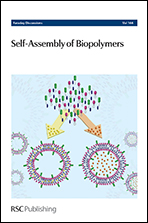αs-Casein–PE6400 mixtures: a fluorescence study
Abstract
Micelles are a potential encapsulation system for bioactive compounds. In previous studies we were able to show that the triblock copolymer PEO13-PPO30-PEO13 and αs-casein are miscible within distinct temperature and concentration ranges. In this study, we wanted to test our hypothesis that mixed micelles are formed which, in turn, are able to solubilize hydrophobic compounds. Additionally we want to gain insight into the specific arrangement of individual molecules in these micelles. For that purpose, mixtures containing increasing mole fractions of casein (αcas = 4.3 × 10−4 to αcas = 7.2 × 10−3) were examined at 30 °C. The hydrophobic fluorescence probe pyrene was used as a model solute. Emission spectra were recorded and I1/I3 and Iex/I1 ratios were evaluated. Furthermore, the emission spectra of tryptophan were recorded and the maximum emission wavelength was evaluated. The determined parameters showed that micelles are formed in all solutions and that the solubilization of pyrene occurred. The calculated interaction parameter β indicated that the mixing was antagonistic, possibly due to steric hindrances between the casein and the polymer. It seems that the mixed micelles are formed in such a way that the hydrophobic part of the polymer is attached to the hydrophobic parts of the caseins (a necklace and bead model) since the tryptophan residues are located in a hydrophobic environment above the CMC. We suggest a first structural arrangement model, recognizing that further studies will be required to prove and refine it.
- This article is part of the themed collection: Self-Assembly of Biopolymers

 Please wait while we load your content...
Please wait while we load your content...